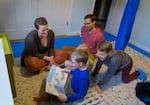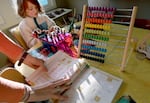This is the first story in a series about the state of special education in Oregon, including how students and educators are faring after years of pandemic disruptions.
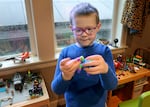
Oli Weith, 7, plays at his home in Southeast Portland on Dec. 29, 2022. Oli has autism spectrum disorder and is a second grader at Buckman Elementary, where his parents say he does not receive adequate support.
Elizabeth Miller, Elizabeth Miller / OPB
Last year, Andrew and Sara Weith went to Glencoe Elementary School to see their son Oli, then a first grader, present a project with his class. Each student had to plan a farm, name it, pick out the animals that would be there, and decide what the farm would look like. Oli’s Rainbow Dragon Farm presentation was a big moment for the family.
“It was really emotional for Andy and I,” Sara Weith recalled. “He did the entire project with the help of an aide, but he did the whole thing by himself and was able to be in a big room and [he] presented to people and all the things.”
Oli has autism spectrum disorder. He had a bumpy start to last school year. But after advocacy from Oli’s parents and the principal, Oli received an aide who would help him for about 80% of the day. The aide would intervene with Oli if his behavior escalated or if he got upset.
This year, Oli is in second grade at Buckman Elementary, another Southeast Portland school. His parents moved Oli to Buckman after hearing he wouldn’t receive the same support as he had in first grade, and instead could be moved into a separate, specialized classroom. But when Oli changed to Buckman, he didn’t get one-on-one support. His parents say the school didn’t set academic expectations for their son who spends his school day in a special ed classroom focused on social and emotional skills. Oli’s teacher is often left as the only adult in the room with several students with high needs.
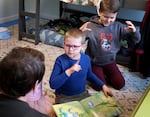
(Left to right) Sara Weith talks with Oli, 7, as big brother Gus, looks on at their home in Portland, Dec. 29, 2022.
Elizabeth Miller / OPB
Oli has not taken well to the situation at Buckman.
Oli calls his parents daily from the classroom and they try to help him over the phone.
The 7-year-old has been leaving the school grounds on his own. One time, Oli ended up in a neighbor’s yard. Another time, his parents said a janitor found Oli outside barefoot.
When the school calls, Sara Weith braces herself for the worst.
“The biggest concern is that I am terrified they’re gonna call me and say he was hit by a car or he went outside and got picked up by a van with no windows in it,” Weith said.
OPB’s interviews with parents and staff members suggest the difficulties Oli is having aren’t simply the differences between one neighborhood elementary school and another. Entire systems of special education are fraying, as teachers, administrators and support staff try to stretch limited resources to meet intense needs.
Schools are as close to resembling pre-pandemic operations as they’ve been since March 2020. But in special education, schools are falling far short of full support and staffing. That leaves students in special education physically at risk and academically unserved — even though they are among the student groups in greatest need after more than two school years of pandemic disruptions.
National Assessment of Educational Progress, or NAEP, scores, showed the gap between students with disabilities and other students remains wide in math, with smaller gaps in reading. But details are scant on what’s happening with students with disabilities, even as researchers, such as the Center for Reinventing Public Education, have attempted analyses.
What we do know is schools have struggled to serve students with disabilities. Some students were unable to access lessons when school was online. Similar to their peers, disabled students’ mental health suffered.

(Left to right) A family photo shows Oli presenting his Rainbow Dragon Farm at Glencoe Elementary last year, along with a detail from his project. This year, at a new school, his parents say he doesn’t have the one-on-one support he needs to do class work.
Elizabeth Miller / OPB
Sara and Andy Weith’s son Oli showed progress last year. This year, without the support of an aide, their son is struggling. Under his individualized education plan, Sara and Andy say, their son is supposed to spend time in a general education classroom. That hasn’t happened.
“He doesn’t leave the focus classroom … he doesn’t go to any of the other classes, because Dixie [DeGraw, Oli’s teacher] doesn’t have the resources to help support him in that transition,” Sara Weith said.
This year, Oli is in a room for kindergarteners, first and second graders. Next year, he’ll be a third grader in a classroom of students his age and older.
The Weiths have behavior and academic concerns about Oli moving to a new grade with older students next year, and they say professionals who work with their son back that up.
“He’s not getting an education, he’s not safe, and we don’t know what to do,” Sara Weith said. “Because the resources we were ensured he would have access to in this specialized classroom is not there.”
From teachers to paraeducators, resources are spread thin
It takes a lot of people to run a school.
In a special education classroom, there might be multiple adults and students going in and out over the course of a day. Classroom aides or paraeducators spend time one-on-one with students. Speech language pathologists may pull a student out of class to work on building skills. A special education teacher may take a student to a general education classroom, offering the student support with a lesson.
Staffing has long been a problem, even before the pandemic — and not just in special ed. But when it comes to special education, consistent staff relationships are key to keeping students engaged and maintaining a supportive learning environment. Finding teachers with the necessary skills and dedication has always been hard.
Jeffrey Fuller recently counted the special education positions open in his district. Fuller, president of the Reynolds Education Association and a high school history teacher in the eastern Multnomah County school district, counted more than 20 open positions — from educational aides, to a speech language pathologist, to social workers, to a life skills class teacher.
At board meetings this fall, he and Oregon School Employees Association representative Sheila Holt testified about staff feeling burned out and overwhelmed with large caseloads. The union leaders warned that the district might be depriving students of what they’re legally entitled to, under their individualized education plans.
During the depths of the pandemic, COVID-19 undermined services to children with disabilities. Fuller says staffing shortages and inadequate funding are shortchanging those students now.
“Our most marginalized students, again, are the ones feeling the consequences of that the most,” Fuller said.
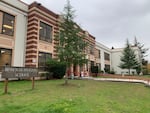
Roseway Heights Middle School in Northeast Portland.
Courtney Sherwood / OPB
Like many schools across Portland and throughout the country, Roseway Heights Middle School in Northeast Portland started this school year with positions unfilled, especially one-on-one support staff.
At the beginning of the year, there were no paraeducators in the school, leaving two students without the one-on-one support required under their IEPs. A teacher had to do the work of a paraeducator while also trying to manage a class of students.
“She’s, you know, walking him to his classes, being with him in his classes, taking him to the bathroom,” said Susan Carson, the parent of one of the students who needs one-on-one support.
Later in the year, the school hired a few paraeducators. But a lack of paraeducator substitutes from one day to another created a similar problem. Again, the special education teacher or a district administrator was forced to cover the role of a paraeducator for the day — temporary solutions to a seemingly unending problem.
Carson wondered about the “domino effect” of moving staff around. Losing a teacher for a day can reverberate throughout a school — from the students who don’t receive that one-on-one support to the students not in special education at all.
“When was she supposed to do her paperwork? All those IEPs? All the meetings with parents? Preparing her lessons? Doing her small group with all the kids on her caseload?” Carson said.
“Maybe [students] start acting out, and there’s behavior problems … and then the kids who aren’t necessarily in special ed are in turmoil because their peers are acting out. It’s massive.”
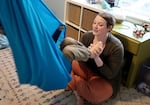
Oli Weith, 7, swings towards his mom, Sara Weith, at their home in Southeast Portland on Dec. 29, 2022. Oli often sits in his swing while his mother reads to him.
Elizabeth Miller / OPB
Mary Darin is a speech language pathologist based at Buckman in Southeast Portland, the same school Oli attends. She evaluates students for services and works with them directly on speech or communication challenges.
Darin said students are not being served in a way that best suits their needs. They may be in a separate focus classroom but would benefit from time in a general ed class. Other students may see interruptions in their services or support, because staff are pulled away to deal with emergencies.
“The biggest behaviors get the most attention and we have a lot of students that would need lower levels of support that aren’t getting it,” Darin said.
Daralee Huntley can see multiple perspectives, as the parent of a student with disabilities at Roseway Heights and a paraeducator herself at a different school in Portland. Huntley formed relationships with some of her fourth graders years ago, when they were in kindergarten.
“What keeps me there is that this is the same support that my daughter gets, so I want to be able to give another family the same satisfaction and [...] the same sense of, a breath of relief that my child is supported at school,” Huntley said.
She said the special education department in general is lacking support, with paraeducators and other staff not feeling included or supported by administrators, despite their important role working directly with students.
Without a fully staffed classroom, the impacts on students and overworked staff are compounded.
“I’ve spoken to so many special educators who feel guilty because they’re not doing what they can for all those students, but on the other hand they know they can’t,” Darin said. “And I just want to say to those special educators, it is not you, it is the system.”
A special education teacher who left PPS this fall, and requested anonymity to avoid possible repercussions, said they never felt like they could catch up. Now working in a different Portland-area district, the teacher has a smaller class. Support from paraeducators allows the teacher time to prepare for classes and do case management work.
Some staff and families say there’s a sense that the district is moving toward a model that, if not fully staffed and resourced, could further undermine the level of services and support students receive.
Continued staffing challenges as service model shifts
Michelle Murer took over as the director of special education at Portland Public Schools in November after serving as interim director.
Murer said her focus over the next two months is on collecting feedback from families and staff involved in the special education program, in order to draft a multiyear plan for the department by the end of 2023.
The goal for PPS now and in the future, she said, is to include and instruct students with disabilities in the general education setting as much as possible, in an effective and efficient way.
But Murer didn’t share any immediate steps to make things more effective or efficient beyond suggestions about changing schedules or mentioning PPS’ Virtual Academy, an online school available to students.
This past fall, Portland Public Schools and the Portland Association of Teachers were in talks over language in their contract. The union hosted a campaign in October to raise awareness about special education challenges, including paraeducator shortages, the safety of students with significant medical needs, and concerns about elementary students in special education accessing a new language arts curriculum.
The district responded with an outline of staffing and resources for students who receive special education services. In that October message, district officials said there were 32 paraeducator vacancies. By late December, Murer said there were still about 20 paraeducator openings and several openings for special education teachers, including some to replace people who left mid-year.
“There’s a true desire to support these kids, and they have a lot of issues that we aren’t certain how … what to do,” Murer said. “We have a lot of kids with mental health issues.”
She acknowledged that unfilled positions impact students.
“There’s going to be some times in a building where people are all running to one situation that’s an emergency situation, that’s going to happen,” Murer said. “But it’s always happened. I just think it’s gotten more news.”
But Murer doesn’t see a quick end to the staffing challenges plaguing districts like PPS.
“We have to rethink to some extent, the best way to do this, because this isn’t going to go away,” Murer said. “I don’t think all of a sudden next year we’re going to have a full staff and all trained … it’s not going to happen overnight.”
But some staff say the challenges can’t wait. Sarah Vazquez, a speech language pathologist and feeding specialist who works across the district, helps students with eating, drinking and other health-related concerns that may be barriers to accessing education.
Vazquez said she is “frightened” there are so few staff working directly to develop safe protocols for students with disabilities.
“My understaffed and undervalued team can’t look parents in the eye and tell them that their kids are safe at school because I can no longer stand by that statement while operating on a skeleton crew,” Vazquez said.
In an October memo about special education staffing, district officials said they reduced the staffing allocation for the feeding team after a speech language pathologist resigned, while also citing the “significant reduction” of students needing support — from 160 students last year to 120 students forecast for this school year.
“What my team does is literally prevent the risk of choking and aspiration, which is an airway-related event, when food enters the airway,” Vazquez said.
“[...] Cutting staffing for these students is probably the last place that staffing should be cut. Because it’s life or death.”
Meantime, students with disabilities and their families are continuing as best they can.
Students left behind
This fall, Sara Schultz pulled her 7-year-old son Keith out of school after moving through three Portland schools in the last year.
Lizzie Boss finally got her 8-year-old son Coen into a Portland elementary school, after trying since 2019. Recently, he started going to Buckman Elementary once a week for 25 minutes, working with Mary Darin on speech.
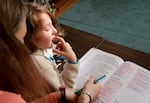
Sara Schultz reading with her son Keith Schultz-Davis, 7, at their home in Northeast Portland on Dec. 14, 2022. Keith has been homeschooled since earlier this year and Schultz is teaching her son how to read.
Elizabeth Miller / OPB
Both Keith and Coen have autism. Both have single parents and have attended Buckman at some point. But instead of spending full days at school, both boys are mostly at home.
On a recent weekday, Keith took a break from playing with Legos to practice reading with his mom. Schultz sat on the couch, Keith on the floor, as they read a story about two cats from “Teach Your Child to Read in 100 Easy Lessons.” After the lesson, Keith practiced writing letters in the workbook, “x” and “er” over and over again while his mom watched.
Both Keith and his twin sister, Lauren, started at a charter school. From there, they moved to Buckman, where Lauren remains enrolled. Keith was referred to Pioneer, a PPS program specifically for students with intense special needs. Schultz said her son was repeatedly restrained and sometimes would spend hours watching TV shows on his iPad at the last two schools. Schultz said her son would run around the school, or curse at teachers. His behavior at home changed too.
Keith wasn’t enjoying school anymore, or learning, his mom said.

Sara Schultz is teaching her son Keith how to read through the book, “Teach Your Child to Read in 100 Easy Lessons.”
Elizabeth Miller / OPB
“He said, ‘all days are bad days now,’ and he also was saying stuff like, ‘I’m a stupid kid, all the bad things people think about me are true,’” Schultz recalled.
Keith shut down, Schultz said. She decided to homeschool him, where she said his communication returned and his behavior improved. Lauren is still at Buckman.
“I just wanted my kid to get taken care of and be able to be in school,” Schultz said. “And it’s sad now because he’s at home, and he likes kids, and I hate that he’s not going. I don’t know how long it will take for him to feel safe and trust adults.”
Lizzie Boss has been in touch with PPS since 2019, in hopes of setting up the right learning environment for Coen. She and the district haven’t reached a solution, even after Boss hired an attorney. Boss said the district never offered her son a “low sensory” environment she says he needs, with supportive teachers and paraeducators, and classmates like him.
Boss said her son spends a lot of time in his room, alone, building or doing crafts.

Keith Schultz-Davis, 7, plays with Legos at his home in Northeast Portland on Dec. 14, 2022.
Elizabeth Miller / OPB
“It’s infuriating as a parent, and heartbreaking, and disheartening, that I’m watching this brilliant little child building these magnificent structures — but he should be in school learning,” she said.
She’s been trying to teach him how to read. But Boss isn’t a teacher, and doesn’t know all of the things he needs — or may even have access to — at school.
“I want him in school now, I want him around peers that challenge him but that are not scary for him, and I want him learning,” Boss said.
“I want a basic education for my child on his level.”
Our next story is about the academic challenges facing students with disabilities — from interventions to improve reading, recovery services, and what happens when students don’t get one-on-one support.


